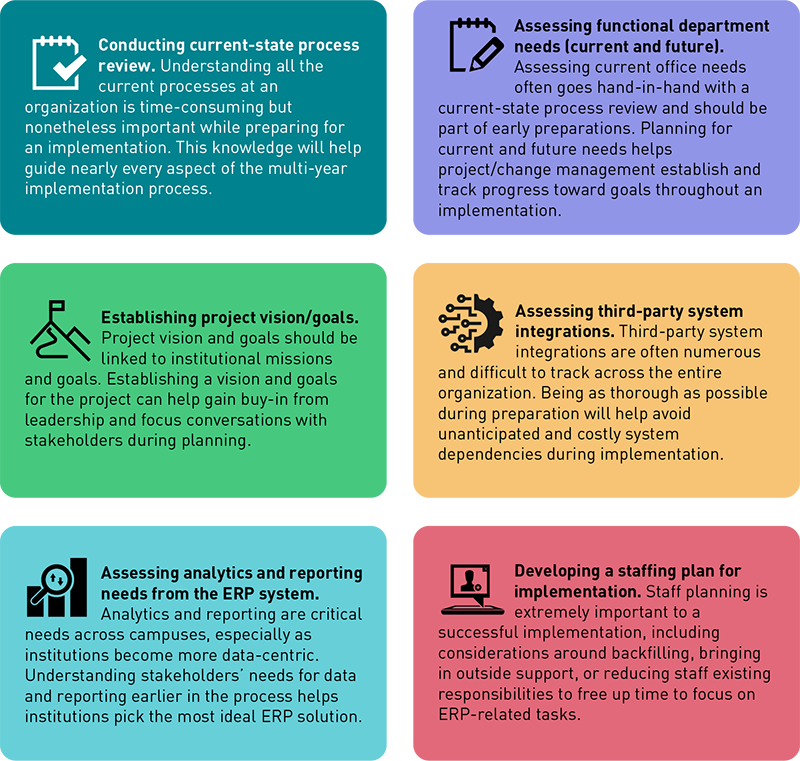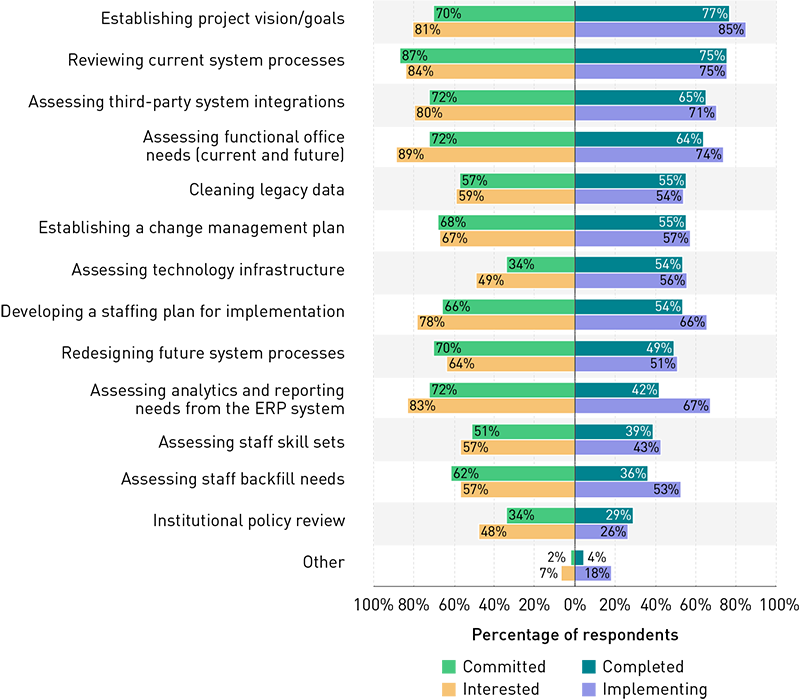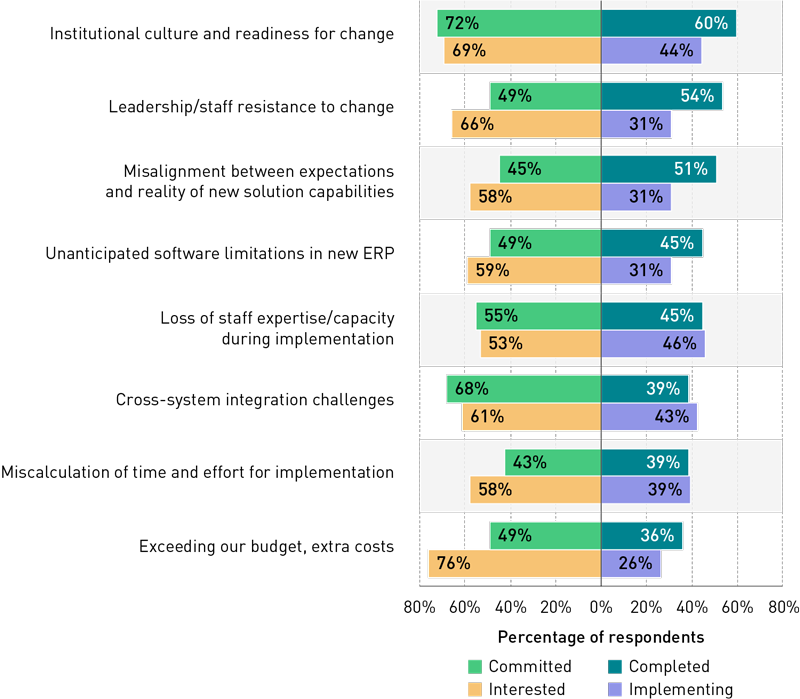Getting Prepared: Pillars of Readiness
An ERP implementation is no small task, and preparation is key. Survey respondents from all four survey groups (interested, committed, implemented, and completed) were generally aligned on the six most important preparations their institution has made or will make for their ERP implementation (see figure 5).

All the preparations we asked about in the survey and interviews would be helpful to most institutions, and indeed those reporting the highest levels of ERP success had utilized most or all the preparations on the list (see figure 6). Paying close attention to the whole list of preparations will give leadership a deep understanding of their institution's unique needs, enable them to relay those needs to the vendor and third-party consultants, and ensure a smooth selection and implementation process. It will also enable them to guide and track progress throughout the implementation while updating stakeholders about their progress toward project goals.

For institutions that have completed or are currently implementing, only the top four preparations really stood out as most important in the data, while those that are committed or interested reported many more preparations as important. With few exceptions, these future-looking institutions plan to address more areas during their preparations than those who went before them.
Failing to properly prepare in the earliest stages of an ERP implementation will likely lead to exceeded budgets, delayed timelines, and other challenges later in the project. Having the benefit of hindsight, those respondents who completed their implementation or are currently implementing were asked to reflect on the preparations they made that ended up being most important for project success. Interestingly, no single preparation emerged as most critical, reinforcing the value in a variety of preparations for ERP readiness.
When asked about the preparations they didn't make that would have been the most helpful, respondents reported a similar variety of preparations, again indicating there is no "silver bullet" when it comes to readiness but rather a comprehensive suite of preparations that must be addressed. Preparation is also situational, and some institutions may naturally focus more on some areas than others. Institutions should look across the list of preparations to identify areas that may need to be supplemented. That said, one comment about a preparation not taken highlights the importance of seeing the big picture of an ERP implementation: "Redesigning future system processes would have made the biggest positive difference. Many of our processes were developed based on our previous software, and were difficult and impractical to set up in the new software."
Which preparations did you not make that would have made the biggest positive difference?
- "Change management, that is the one that MOST leads to the successful adoption of ANY new system. We did some, but not nearly enough for an implementation of this size."
- "My biggest fear at this point is the lack of investment in the change. There is a tremendous upfront cost that cannot be overlooked. I believe it is worth it, but must be clearly understood."
- "We should have gotten sustained top-level executive support and involvement throughout the project, or it shouldn't have moved forward. Our College leadership is somewhat supportive, but they don't really understand why the project is being done or how critical that it is a success."
- "Assessing staff backfill needs. Staff was expected to carry on their current workload while implementing new system. They're having to run parallel systems."
- "Strong project management office and framework. We had to rework partway into the first implementation project."
- "Assessing analytics and reporting needs because users had a hard time finding information they knew they had in the older reports."
- "Policy reviews and redesigning of processes. These two go hand-in-hand, and we had no idea to what extent processes were going to change. We're going from a system that has no end-user interaction to one that relies on self-service. Huge changes that most didn't consider."
- "More up-front expectation setting with functional offices and users, including fair warning that the process would be somewhat painful."
- "We should have spent more time on training and skill-development. It was hard to transition off of implementation partner support due to knowledge gaps."
- "Assessing third-party system integrations should have been completed much earlier in the process."
- "Communicate early and widely regarding the upcoming changes."
Early needs assessments provide a customized roadmap for each institution. Conducting a needs assessment during the early stages of an ERP implementation helps project teams plan how and when to address departmental needs across campus and avoid costly, time-consuming changes to the project. Project and change management leaders can help conduct the initial assessment and revisit and adjust the assessment findings as needed throughout the project.
Interviewees reported a number of benefits achieved by conducting early needs assessments:
- Improved alignment between the ERP system and the organization's business processes
- Reduced risk of implementation failure
- Increased user satisfaction with the new system
- Faster time to providing value
- Beginning of a regular communication process with key project stakeholders
Interviewees reported using a number of methods for their needs assessment process throughout their projects, including interviews, focus groups, surveys, and workshops.
The specific approach to needs assessment will depend on the size and complexity of the organization. It is important to involve a broad range of stakeholders in the assessment process to ensure all needs are identified and incorporated into project goals, particularly as those goals target deeper institutional transformation. As one survey respondent shared, early assessments helped with "redesigning future system processes…because the aim of digital transformation is to transform the process to make it more comfortable and flexible for the future."
Understanding the variety of implementation challenges you may encounter can enhance preparation and reduce setbacks. Any project requiring years of complex, coordinated work to cross the finish line will be full of challenges (see figure 7). Change is difficult, especially when the project involves the entire institution and requires people to learn new work processes as part of learning a new system. Given this, it's not surprising that survey respondents reported resistance to change as the most common challenge they have faced or will face during an ERP implementation.

Another commonly reported challenge is adapting to the capabilities of new ERP systems. It is difficult to predict how a new system will function, what limitations you might encounter, and whether or how system capabilities can provide important integrations and outputs that stakeholders rely upon. The good news for ERP project stakeholders is that, beyond an unanticipated crisis or another pandemic (which made up the majority of "other" responses), all of these challenges can be managed, especially with proper preparation.
It is encouraging to see that committed and interested respondents in particular recognize all the many challenges they may encounter, so they can anticipate and make additional necessary preparations and then monitor their projects throughout for signs of trouble.
How Oregon State University Is Setting Up for Success Before They Commit to a New System
Started with a strategic plan aligned with institutional goals. The plan has goals to support digital transformation and modernize business processes, creating a more agile organization.
Planned a two-day boot camp with senior leadership to understand and align on a change management plan. The first boot camp will help everyone understand the importance of change management and create a common vocabulary. They're bringing in a change management consultant to help find the right framework for OSU. The second bootcamp will be to gather support and cultivate alignment with leaders on the approach and to collaborate on the design principles that will be the cornerstones of the program to guide direction and teams in the transformation.
Dedicated functional roles across campus to assist with implementation. OSU leaders are asking themselves:
Do we have people who can fill these roles?
If not, how do we fill these roles? Consultants, backfilling, temporary positions, or shifting responsibilities?
"What we've heard consistently is how important it is to have a change champion team with representatives from departments from across the university. These will be the point people to communicate with departments, schools, or divisions and bring information back about how people are feeling, where they're excited, where there is fear, or where people are dragging their feet."